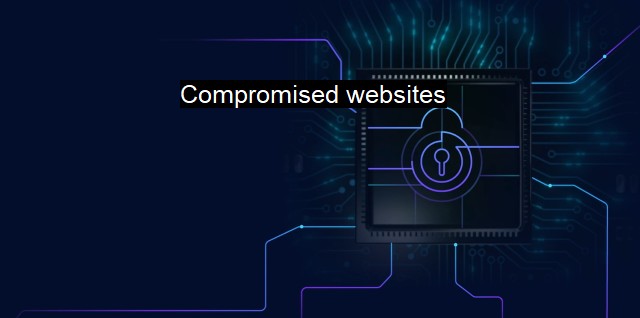What are Compromised websites?
The Growing Threat of Compromised Websites: Why Web Security is Crucial in Today's Digital Era
A compromised website is a website that has been attacked by cybercriminals or hackers who have altered its programming for malicious intent. These cybercriminals infiltrate websites' security defenses to accomplish a variety of aims such as stealing data, distributing malware, or launching attacks on other websites. understanding compromised websites and how to prevent such compromises is critical.Primarily, a compromised website is a central issue in cybersecurity as it allows cybercriminals to gain unauthorized access to sensitive data. Personal, financial, and proprietary information can be exfiltrated that the website holds, which can lead to severe consequences for the organization owning the website and users who entrust their information to it. The consequences range from simple inconveniences to severe legal repercussions, such as fines for violating privacy regulations.
Notably, cybercriminals often use compromised websites to distribute malware – software that is designed to impair computer operations, steal data, or access private systems. Malware can lead to various cybersecurity catastrophes, like infecting users' computers with viruses, trojans, ransomware, or spyware. Cybercriminals also use compromised websites as platforms to launch 'malvertising' attacks, engaging in the act of embedding malware within advertisements which unwitting users click on and thus infect their own devices.
By altering the coding of a website, cybercriminals can launch attacks on other computers and websites. This represents a multitude of challenges as controlling a popular, compromised website gives the cybercriminals the power to manipulate a wide array of naive users and sophisticated systems.
How are websites compromised? Websites get compromised through numerous methods. Sadly, in many situations, the fault lies with the website's administrators for not taking sufficient precautions and adopting appropriate cybersecurity strategies. This might involve failing to update the website's software or plugins to their latest versions, neglecting to use strong and unique passwords, not implementing a firewall, and not taking network security seriously.
Combating this problem requires executing the right cybersecurity measures. This includes using an updated and sophisticated IT security infrastructure that includes utilizing an antivirus software. Antivirus software helps protect against known threats by identifying and eliminating them before serious damage can occur. It uses a database of known virus definitions to locate threats and eradicate them from the system, thereby enhancing the system's overall security.
People who operate websites should also consider utilizing web application firewalls (WAFs), which screen, filter, and block HTTP traffic to and from a web application and protect against hacking attempts. Regular updates and patching are also crucial to remedy weaknesses in the website's infrastructure or the programs that it runs.
In educating users, they must be aware of not providing sensitive data to untrusted sites, and being cautious of free downloadable content. It is sensible to invest in highly-rated virus protection, ensure their devices are updated with the latest patches and updates, and increase their vigilance to avoid falling victim to compromised websites.
Compromised websites pose a serious threat to cybersecurity and data protection. Staying updated with the latest security software and practices, applying multi-layered protection measures, thorough user vigilance, education about fishing or social engineering sites, along with a robust antivirus software solution, can help in lowering the risk. More importantly, demonstrating cybersecurity hygiene in dealing with websites can protect users from compromised websites and ensure a safer browsing experience.
The modern world of cybersecurity is an ongoing battle that wedges a war against time, users, platforms, applications, awareness, and the progressively sophisticated tactics at the disposal of cybercriminals. As such, understanding compromised websites is crucial, not just in maintaining website integrity, but also for preserving personal online safety and improved online browsing and internet experience. Companies or individuals that neglect the cybersecurity aspects may regret their decisions, given the significant risks compromised websites hold.

Compromised websites FAQs
What is a compromised website?
A compromised website is a website that has been hacked or infiltrated by cybercriminals to carry out malicious activities. This can include stealing sensitive information, distributing malware, or using the website for phishing attacks.How can I tell if a website has been compromised?
There are several signs that a website has been compromised, including unexpected pop-ups, changes to the website's appearance or behavior, and warnings from antivirus software. If you suspect a website has been compromised, it's best to avoid visiting it and alert the website's owner or your IT department.What should I do if I've visited a compromised website?
If you've visited a compromised website, you should immediately run a virus scan on your device to check for any malware that may have been downloaded. If you've entered any sensitive information on the website, such as your login credentials or credit card details, you should change your passwords and monitor your accounts for suspicious activity.How can I prevent my website from being compromised?
To prevent your website from being compromised, you should keep your software and security measures up to date, use strong passwords and two-factor authentication, and regularly scan your website for vulnerabilities. It's also important to educate your users about safe browsing habits and provide resources for reporting any suspicious activity.| | A | | | B | | | C | | | D | | | E | | | F | | | G | | | H | | | I | | | J | | | K | | | L | | | M | |
| | N | | | O | | | P | | | Q | | | R | | | S | | | T | | | U | | | V | | | W | | | X | | | Y | | | Z | |
| | 1 | | | 2 | | | 3 | | | 4 | | | 7 | | | 8 | | |||||||